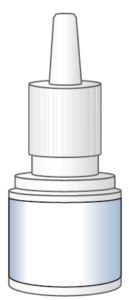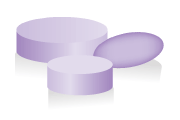Sumatriptan for migraine headaches
This leaflet is for parents and carers about how to use this medicine in children. Our information may differ from that provided by the manufacturers, because their information usually relates to adults. Read this leaflet carefully. Keep it somewhere safe so that you can read it again.
Name of medicine
Sumatriptan
Brand names: Imigran, Imigran Radis
Why is it important for my child to take Sumatriptan?
Sumatriptan is used at the start of a migraine headache to try to stop it getting worse. Migraine headaches can be caused by the blood vessels in the brain expanding. Sumatriptan helps to constrict (narrow) these vessels and stop the migraine.
Your child should only use this medicine once they know they are going to have a migraine or are actually having a migraine headache. It will not prevent a migraine or cluster headache from starting.
What is Sumatriptan available as?
This medicine is most commonly given as a spray into the nose but it can also be given as a tablet.
- Sumatriptan nasal spray is available as 10 mg or 20 mg per spray.
- Tablets (Imigran) and dispersible tablets (Imigran Radis): 50 mg; 100 mg
If you have any concerns or questions, speak with your child’s doctor or pharmacist.
When should I give Sumatriptan
Your child should usually take this medicine as soon as they feel a migraine headache starting.
How much should I give?
Your doctor will work out the amount of sumatriptan (the dose) that is right for your child. The dose will be shown on the medicine label.
If the migraine headache comes back after 2 hours or more, then a second dose can be given. No more than 2 doses should be given in 24 hours.
It is important that you follow your doctor’s instructions about how much to give.
How should I give Sumatriptan?

Nasal spray
- Insert the nozzle of the spray as far up one nostril as is comfortable. Spray the dose directly into their nose.
- You should not tip your child’s head backwards. Keep their head in the normal position or tilt their head slightly forward. This stops the spray running down the back of their throat.
- Only use the spray in both nostrils if your child has been prescribed two sprays.

Tablets
- Tablets should be swallowed with a glass of water, squash or juice. Your child should not chew the tablet.
Imigran Radis tablets
- These can be dissolved in a small amount of water, although it will have a bitter taste. To hide the taste of the liquid medicine, you can use fruit juice, milk or squash instead. Your child should drink it all straight away. Then add some more water, squash or milk to the glass, swirl it around and ask your child to drink it. This makes sure they get all the medicine.
When should the medicine start working?
The medicine should start working 15 minutes after it is given. If the migraine headache comes back after two hours or more, then a second dose can be given. No more than 2 doses should be given in 24 hours.
What if my child is sick (vomits)?
It is very common for children to be sick (vomit) at the start of a migraine headache.
- Sumatriptan is usually given as a nasal spray. You do not need to worry if your child is sick, as the medicine will still work.
- If your child is sick after having the tablet, it is probably best not to give another dose. If your child is usually sick at the start of a migraine headache, you can discuss using the nasal spray with your doctor or pharmacist.
What if I forget to give it?
This medicine should only be given when your child is about to have, or already has, a migraine headache. If you forget to give it, you can give it later on if they have another migraine or if the migraine is continuing, but do not give more than 2 doses in 24 hours.
What if I give too much?
You are unlikely to cause harm if you give an extra dose of Sumatriptan by mistake. If you are concerned that you may have given too much, contact your doctor or local NHS services (details at end of leaflet). Have the medicine or packaging with you if you telephone for advice.
Are there any possible side effects?
We use medicines to make our children better, but sometimes they have other effects that we don’t want (side effects).
Side effects you must do something about
If your child is short of breath or is wheezing, or their face, lips or tongue start to swell, or they develop a rash, they may be allergic to Sumatriptan. Take your child to hospital or phone for an ambulance straight away.
Other side-effects you need to know about
Some of these side-effects may be caused by your child’s migraine headache. If they get worse after taking sumatriptan or if you are concerned, contact your doctor.
- Your child may get a strange taste in their mouth
- Your child may have an irritating or burning feeling in their nose or mouth; they may occasionally have nose bleeds with the nasal spray. Your child may have strange sensations in their body. They may feel tingling, warm, heavy or a feeling of pressure or tightness of any part of the body (including the chest and throat).
- Your child may also feel weak or tired and feel sick (nausea) or be sick (vomit).
Your child may get flushed or dizzy.
There may sometimes be other side effects that are not listed above. If you notice anything unusual and are concerned, contact your doctor. You can report any suspected side effects to a UK safety scheme at mhra.gov.uk/yellowcard
Can other medicines be given at the same time as Sumatriptan?
- You can give your child medicines that contain paracetamol or ibuprofen, unless your doctor has told you not to.
- Sumatriptan should not be taken with some medicines. Tell your doctor or pharmacist about any other medicines your child is taking before giving Sumatriptan.
Check with your doctor or pharmacist before giving any other medicines to your child. This includes herbal and complementary medicines.
Is there anything else I need to know about this medicine?
- Make sure your child’s teachers know about their medicine. Your child should keep the medicine with them and may need to use it at school if they feel they are starting to develop a migraine headache.
General advice about medicines
- Only give this medicine to your child. Never give it to anyone else, even if their condition appears to be the same, as this could do harm.
- If you think someone else may have taken the medicine by accident, contact your doctor or NHS local services (details at end of leaflet) for advice.
- Make sure that you always have enough medicine. Order a new prescription at least 2 weeks before you will run out.
- Make sure that the medicines you have at home have not reached the ‘use by’ date on the packaging. Give old medicines to your pharmacist to dispose of.
- If you are not sure a medicine is working, contact your doctor but continue to give the medicine as usual in the meantime. Do not give extra doses, as you may do harm.
Where should I keep this medicine?
- Keep the medicine in a cupboard, away from heat and direct sunlight.
- It does not need to be kept in the fridge.
- Make sure that children cannot see or reach the medicine.
- Keep the medicine in the container it came in.
Who to contact for more information?
Your child’s doctor and pharmacist will be able to give you more information about Sumatriptan and about other medicines used to treat or prevent migraine headaches.
England: NHS 111
Tel 111
www.nhs.ukScotland: NHS 24
Tel 111
www.nhs24.scotNorthern Ireland: NI Direct
Wales: NHS 111 Wales
Tel 111
www.111.wales.nhs.ukThe Migraine Trust
0203 9510 150
www.migrainetrust.org/Copyright disclaimer
Version [1]. © NPPG, RCPCH and WellChild, all rights reserved. Review by July 2019.
The primary source for the information in this leaflet is the British National Formulary for Children. For details on any other sources used for this leaflet, please contact us through our website, www.medicinesforchildren.org.uk.
We take great care to make sure that the information in this leaflet is correct and up-to-date. However, medicines can be used in different ways for different patients. It is important that you ask the advice of your doctor or pharmacist if you are not sure about something. This leaflet is about the use of these medicines in the UK, and may not apply to other countries. The Royal College of Paediatrics and Child Health (RCPCH), the Neonatal and Paediatric Pharmacists Group (NPPG), WellChild and the contributors and editors cannot be held responsible for the accuracy of information, omissions of information, or any actions that may be taken as a consequence of reading this leaflet.
